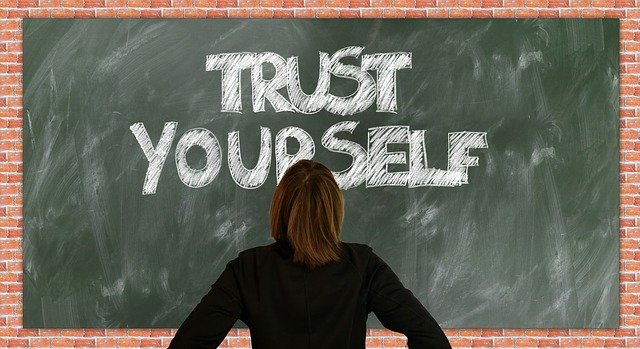In the interview podcast with Tami Simon of Sounds True, Patricia Stark discussed some of the exercises and tools covered in her book that provide ways to develop Calmfidence – calm confidence in the face of life’s challenges. Patricia’s book Calmfidence addresses barriers to confidence including personal past history, perfectionism and the issue of negative self-talk (or the “inner critic” as she calls it).
Her book tracks her own journey to achieving calm confidence as well as provides very practical approaches to creating Calmfidence in our own life. The focus of her book is on situations where we are placed in the limelight such as public speaking, presentations, being interviewed for a job or performing in a public arena. While these situations are the primary catalyst for her book, the principles and practices she shares are relevant to challenges in everyday life. Fundamentally, in her view, you cannot have genuine and sustainable confidence without inner calm.
Exercises and tools to develop calm confidence
Patricia discussed several exercises and practices that could be used in a variety of situations to be able to approach the inherent challenges with calm confidence. Some of these are:
Managing nerves – Patricia like many other authors and commentators contends that nerves help you be more aware and to prepare properly so as to reduce (but not eliminate) the unknown and unpredictable. Nerves indicate that you care and care enough to be worried about the outcome for the people you are helping. When we are not nervous, we may have stopped caring which may be the result of ”compassion fatigue”. Even highly accomplished professionals become nervous before an event. Alfie Langer, an Australian Rugby League legend, used to become quite nervous and nauseous before a match, even in his latter playing days.
So the challenge Is to manage your nerves, not eliminate them altogether. Patricia recounts the comment of a professional performer who told her that “our job is to get the butterflies flying in formation”, not to do away with them. Patricia maintains that what is necessary is to have the courage to reflect on the uncomfortable feelings and what they say to you and about you. She suggests that failure to address the fear and discomfort will “work against you”. In her words, you have to “start to feel the butterflies” which can help you to become “desensitised” to their presence.
Simultaneously, with facing your nervousness and its bodily manifestation, it is important to reaffirm why you are undertaking the public activity and what people can gain from it. You can reinforce this positive thinking by being grateful for the experience of helping others through utilising your unique mix of experiences, acquired skills and resources.
Snow Globe exercise – during the podcast, Patricia led listeners in this exercise. Basically it involves envisaging your mind as a snow globe and viewing your troubled thoughts as the snow flakes descending slowly to the bottom so that they appear as “fallen snow”. This can be accompanied by taking a deep breath and holding it briefly and releasing it in time with the falling snow and the settling of your troubled thoughts. Patricia asserts from her own experience, that this exercise can clear your mind and slow your heart rate so that you can “think straight” and respond to challenges more appropriately.
Visualising Success – this is not success in materialistic terms but with regard to achieving what you set out to do in terms of helping people. Patricia suggests that you start with deep breathing and as you breathe in envisage absorbing calmness and confidence and as you breathe out envisage letting go anxiety and stress. The next step is to visualise your public activity going really well and people providing feedback that is very positive and affirming. She suggests too that you envisage our voluntary audience as ”allies” who are “eager to learn” rather than uninvolved critics with nothing better to do than critique your offering and/or performance.
Sack of potatoes exercise – with this exercise you envisage your body as a “sack of potatoes” with each lumpy potato (uncomfortable feeling) confined by the sack (the mind) that holds them together and contains them. The next step is to envisage taking a pair of scissors and cutting open the lower part of the sack so that the potatoes (uncomfortable feelings) fall out “one by one”. Then you can envisage the sack of potatoes crumpled in a corner, empty of its ingredients. Tami from Sounds True reinforced the value of this exercise by sharing her own experience of undertaking the “sack of potatoes” practice.
Retreating when you hit a rough patch – Patricia describes a period during the pandemic where she was feeling overwhelmed by the book commitments/deadlines and the need to “protect herself and her family”. She decided that she would “have to retreat” in order to “keep her head above water”. She consciously made the choice to give herself some slack and “do nothing”. Patricia was then able to emerge from this period with renewed energy and heightened insight.
Reflection
I have found in the past that what helped me to calm my nerves before a public activity such as a presentation or a workshop, was to revisit a successful prior event and recapture the positive feelings and audience response and use that as an anchor for a forthcoming event. This taps into your sense of self-efficacy – your belief, based on experience, that you are capable of competently undertaking a specific task.
I also found when I was writing my PhD dissertation that I needed to take a break from it in the latter stages. I achieved this by going away to Stradbroke Island with my family for a few weeks. It was while I was sitting on the bank of Brown Lake, watching the boys play in the water, that I gained new insights in to a model that would effectively integrate the focus and findings of my doctoral research. There are times when we need to take a break, change our focus (from self-absorption to other-focused) and absorb the calmness and healing power of nature.
Patricia’s book contains many personal stories of how “Calmfidence” has played out in her life and offers other exercises and tools besides those mentioned here. If you access her book’s sales page, you can view and download the first 10 pages of her book (in PDF format) where she explains six “Calmfidence Boosters” to help you develop the calm confidence needed to manage life’s challenges.
As we grow in mindfulness through nature, meditation, reflection or other mindfulness practices, we can achieve a calm confidence, gain increased understanding and insight and manage life’s challenges more effectively.
___________________________________________
By Ron Passfield – Copyright (Creative Commons license, Attribution–Non Commercial–No Derivatives)
Disclosure: If you purchase a product through this site, I may earn a commission which will help to pay for the site, the associated Meetup group, and the resources to support the blog.









